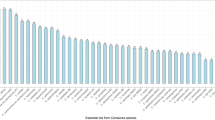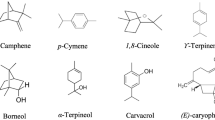Abstract
The antibacterial effects of Thymus vulgaris (Lamiaceae), Lavandula angustifolia (Lamiaceae), and Calamintha nepeta (Lamiaceae) Savi subsp. nepeta var. subisodonda (Borb.) Hayek essential oils on five different bacteria were estimated. Laboratory control strain and clinical isolates from different pathogenic media were researched by broth microdilution method, with an emphasis on a chemical composition–antibacterial activity relationship. The main constituents of thyme oil were thymol (59.95%) and p-cymene (18.34%). Linalool acetate (38.23%) and β-linalool (35.01%) were main compounds in lavender oil. C. nepeta essential oil was characterized by a high percentage of piperitone oxide (59.07%) and limonene (9.05%). Essential oils have been found to have antimicrobial activity against all tested microorganisms. Classification and comparison of essential oils on the basis of their chemical composition and antibacterial activity were made by utilization of appropriate chemometric methods. The chemical principal component analysis (PCA) and hierachical cluster analysis (HCA) separated essential oils into two groups and two sub-groups. Thyme essential oil forms separate chemical HCA group and exhibits highest antibacterial activity, similar to tetracycline. Essential oils of lavender and C. nepeta in the same chemical HCA group were classified in different groups, within antibacterial PCA and HCA analyses. Lavender oil exhibits higher antibacterial ability in comparison with C. nepeta essential oil, probably based on the concept of synergistic activity of essential oil components.






Similar content being viewed by others
References
Russell AD (2003) Biocide use and antibiotic resistance: the relevance of laboratory findings to clinical and environmental situations. Lancet Infect Dis 3:794–803
Bakkali F, Averbeck S, Averbeck D, Idaomar M (2008) Biological effects of essential oils—a review. Food Chem Toxicol 46:446–475
Griffin SG, Wyllie SG, Markham JL, Leach DN (1999) The role of structure and molecular properties of terpenoids in determining their antimicrobial activity. Flavour Frag J 14:322–332
Burt S (2004) Essential oils: their antibacterial properties and potential applications in foods—a review. Int J Food Microbiol 94:223–253
Tan B, Liang Y, Yi L, Li H, Zhou Z, Ji X, Deng J (2010) Identification of free fatty acids profiling of type 2 diabetes mellitus and exploring possible biomarkers by GC-MS coupled with chemometrics. Metabolomics 6:219–228
Adams RP (2007) Identification of essential oil components by gas chromatography/mass spectroscopy. Allured Publishing Corporation, Carol Stream
CLSI M07–A08 (2009) Methods for dilution antimicrobial susceptibility tests for bacteria that grow aerobically. Clinical and Laboratory Standards Institute, Wayne
Hu CD, Liang YZ, Guo FQ, Li XR, Wang WP (2010) Determination of essential oil composition from Osmanthus fragrans tea by GC-MS combined with a chemometric resolution method. Molecules 15:3683–3693
Liang YZ, Kvalheim OM, Rahmani A (1993) Resolution of strongly overlapping two-way multicomponent data by means of heuristic evolving latent projections. J Chemometr 7:15–43
Baldovini N, Ristorcelli D, Tomi F, Casanova J (2000) Infraspecific variability of the essential oil of Calamintha nepeta from Corsica (France). Flavour Frag J 15:50–54
Sikkema J, De Bont JAM, Poolman B (1994) Interactions of cyclic hydrocarbons with biological membranes. J Biol Chem 269:8022–8028
Cox SD, Mann CM, Markham JL, Bell HC, Gustafson JE, Warmington JR, Wyllie SG (2000) The mode of antimicrobial action of essential oil of Melaleuca alternifolia (tea tree oil). J Appl Microbiol 88:170–175
Mcdonnell G, Denver-Russell A (1999) Antiseptics and disinfectants: activity, action and resistance. Clin Microbiol Rev 12:147–179
Sikkema J, De Bont JA, Poolman B (1995) Mechanisms of membrane toxicity of hydrocarbons. Microbiol Rev 59:201–222
Ultee A, Kets EPW, Alberda M, Hoekstra FA, Smid EJ (2000) Adaptation of the food-borne pathogen Bacillus cereus to carvacrol. Arch Microbiol 174:233–238
Ultee A, Bennink MHJ, Moezelaar R (2002) The phenolic hydroxyl group of carvacrol is essential for action against the food-borne pathogen Bacillus cereus. Appl Environ Microb 68:1561–1568
Imelouane B, Amhamdi H, Wathelet JP, Ankit M, Khedid K, Bachiri AE (2009) Chemical composition and antimicrobial activity of essential oil of Thyme (Thymus vulgaris) from eastern Morocco. Int J Agric Biol 11:205–208
Verma RS, Rahman LU, Chanotiy CS, Verma RK, Chauhan A, Yadav A, Singh A, Yadav AK (2010) Essential oil composition of Lavandula angustifolia Mill. cultivated in the mid hills of Uttarakhand, India. J Serb Chem Soc 75:343–348
Cavanagh HMA, Wilkinson JM (2005) Lavender essential oil: a review. Aust Infec Control 10:35–37
Xianfei X, Xiaoqiang C, Shunying Z, Guolin Z (2007) Chemical composition and antimicrobial activity of essential oils of Chaenomeles speciosa from China. Food Chem 100:1312–1315
Faleiro ML, Miguel MG, Ladeiro F, Venancio F, Tavares R, Brito JC, Figueiredo AC, Barroso JG, Pedro LG (2003) Antimicrobial activity of essential oils isolated from Portuguese endemic species of Thymus. Lett Appl Microbiol 36:35–40
Krist S, Sato K, Glas S, Hoeferl M, Saukel J (2008) Antimicrobial effect of vapours of terpineol, (R)-(–)-linalool, carvacrol, (S)-(–)-perillaldehyde and 1,8-cineole on airborne microbes using a room diffuser. Flavour Frag J 23:353–356
Mahboobi M, Shahcheraghi F, Feizabad MM (2006) Bactericidal effects of essential oiIs from clove, lavender and geranium on multi-drug resistant isolates of Pseudomonas aeruginosa, Iran. J Biotechnol 4:137–140
Matasyoha JC, Kiplimoa JJ, Karubiub NM, Hailstorks TP (2007) Chemical composition and antimicrobial activity of the essential oil of Satureja biflora (Lamiaceae). B Chem Soc Ethiopia 21:249–254
Soković M, Glamočlija J, Marin PD, Brkić D, van Griensven LJ (2010) Antibacterial effects of the essential oils of commonly consumed medicinal herbs using an in vitro model. Molecules 15:7532–7546
Panizzi L, Flamini G, Cioni PL, Morelli I (1993) Composition and antimicrobial properties of essential oils of four Mediterranean Lamiaceae. J Ethnopharmacol 39:167–170
Oumzil H, Ghoulami S, Rhajaoui M, Ilidrissi A, Fkih-Tetouani S, Faid M, Benjouad A (2002) Antibacterial and antifungal activity of essential oils of Mentha suaveolens. Phytother Res 16:727–731
Marongiu B, Piras A, Porcedda S, Falconieri D, Maxia A, Gonçalves MJ, Cavaleiro C, Salgueiro L (2010) Chemical composition and biological assays of essential oils of Calamintha nepeta (L.) Savi subsp. nepeta (Lamiaceae). Nat Prod Res 24:1734–1742
Acknowledgment
This research was partially supported by the Ministry of Education and Science of the Republic of Serbia (grant no. 171025). We thank Prof. Aldo Roda and the reviewers for critical reviews and constructive comments, which improved the manuscript.
Author information
Authors and Affiliations
Corresponding author
Additional information
Published in the special issue Euroanalysis XVI (The European Conference on Analytical Chemistry) with guest editor Slavica Ražić.
Rights and permissions
About this article
Cite this article
Miladinović, D.L., Ilić, B.S., Mihajilov-Krstev, T.M. et al. Investigation of the chemical composition–antibacterial activity relationship of essential oils by chemometric methods. Anal Bioanal Chem 403, 1007–1018 (2012). https://doi.org/10.1007/s00216-012-5866-1
Received:
Revised:
Accepted:
Published:
Issue Date:
DOI: https://doi.org/10.1007/s00216-012-5866-1




